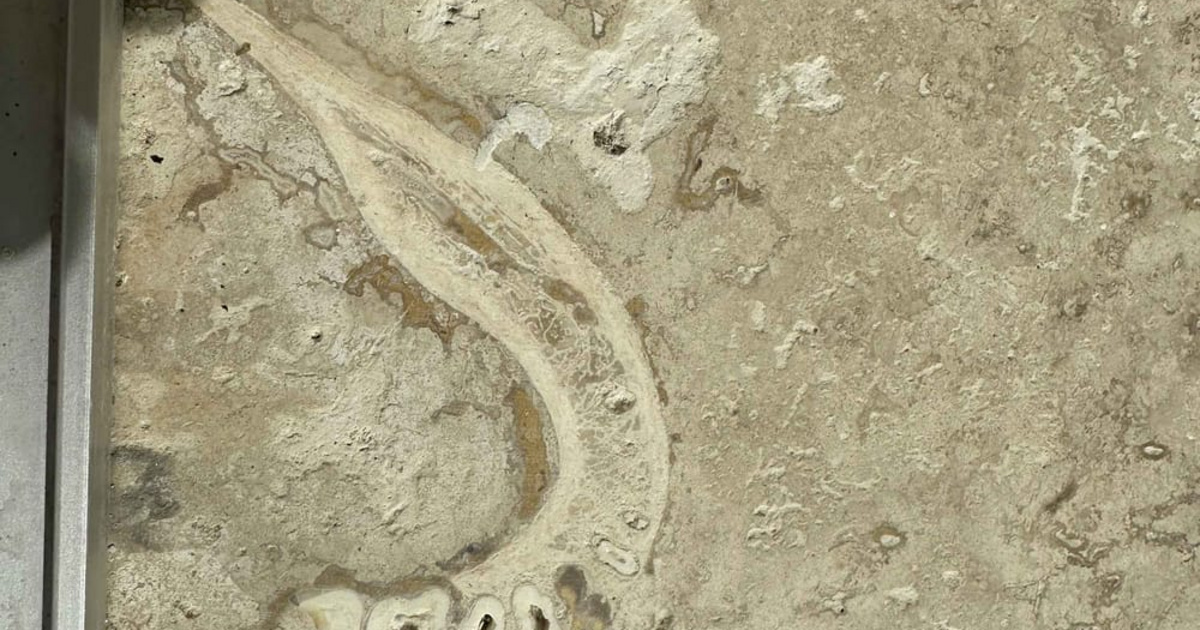A Reddit user who is a plainclothes dentist recently made an interesting post: New siding installed at his parents' house. When he visited them and went to the bathroom, he saw something that a normal person would hardly notice, except to see immediately. One tile showed a polished lower jaw. The rock from Türkiye contained various other fossils, but none as dangerous as the jaw.
The question arises as to how common remains of humans or human ancestors are in natural enclosures and why they are not observed. The answer to the first question is that when it comes to limestone, ancient remains are relatively common.
Cheap bone marble
Travertine, or travertine, is a porous, white and cream-colored stone with beautiful natural veining, but it is cheaper than marble, which is why it is particularly fashionable. It was used as a building material for palaces in antiquity and castles in the Middle Ages. Also called lake limestone, it is usually formed near hot springs by the precipitation of calcium carbonate, from layers of calcite and algae.
The name of the material comes from the place where it was first mined, the ancient Roman name for today's city of Tivoli, Tibur. tiburtin, then Tivertino It was known in its shape – hence the limestone the “Tibor Stone”. Tivoli is located 25 kilometers east of Rome, and limestone was deposited here in an area of about 20 square kilometers and 60 meters thick.
Photo: Kidipadeli75/Reddit
There are about a hundred limestone deposits throughout Italy. In addition, it is found in many places around the world, from the US Yellowstone National Park to Eggerszalok. Italy dominated stone mining until the 1980s, and has since been overtaken by Turkey, and now Mexico, Spain, Greece, Egypt and Iran are serious producers as well.
Since hot springs are particularly pleasant places to live, fossils are very common in limestone, from algae to shells to even large animals. Humans and human ancestors also belong to the latter group, really
Significant results were found
From the quarries that extract these building materials.
In Germany, for example, at the site called Steinrinne, XIX. From the 19th century onwards, numerous bones of ancient elephants, woolly rhinos and macaques have been found, which were found there in the interglacial period, between 470,000 and 280,000 years ago. Since 1969, Dietrich Mania has carried out professional excavations at the site, where he found bones with cut marks and a stone ax mounted on ivory. It is assumed that Homo erectus Details of his skull and jaw have been found – and the scientific position today is that they belong to the early Neanderthal group, Homo heidelbergensis It is considered to remain.
Also significant was the discovery made by Mehmet Cihat Elciçek in 2002 in material from the Kocabaş quarry in Türkiye. This is a two-piece cross section of a human skull, which probably lived sometime between 1.6 and 1.2 million years ago. Homo erectus Rest. It was determined that he may have been suffering from tuberculosis, but the rest of the skull was lost – due to the nature of the manufacturing process, only a few 35mm thick tiles remained.
They don't look, they just see
If the production process has already been discussed, the answer to the other question is that there is no expert person who constantly watches and recognizes when the jaw appears in the wavy pattern. This would not be trivial, however: anyone can identify a cochlea, but only a few experienced specialists will be able to identify cross-sections of bones that differ from those shown in standard anatomy textbooks. Customers choose from a sample at a building materials dealer, and after installing the delivered product, they are faced with the fact that their potential predecessor has become part of the paving slab.
Only a small proportion of the fossils found in limestone can be linked to human evolution, but the extraction of 17,000 tons per year ensures that many more exist. Just as an archaeologist doesn't like the interesting tiles he finds in his hotel room, the forum member's parents didn't rush out with chisels to remove the new covering in their bathroom, either. Meanwhile, if someone looks at it and finds something interesting, they can keep it as a souvenir or put it up for sale in an online auction for a few scoops of ice cream.















































